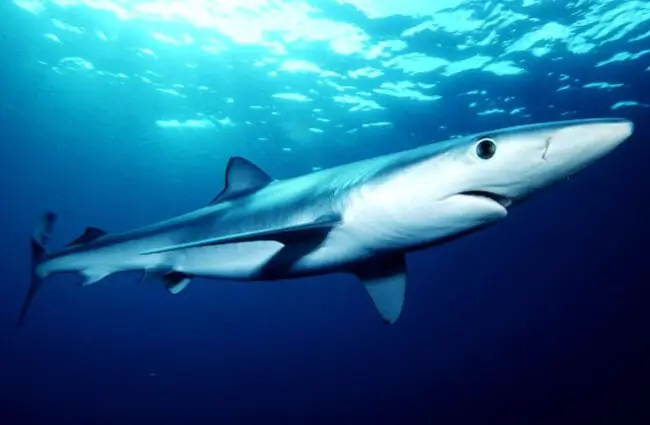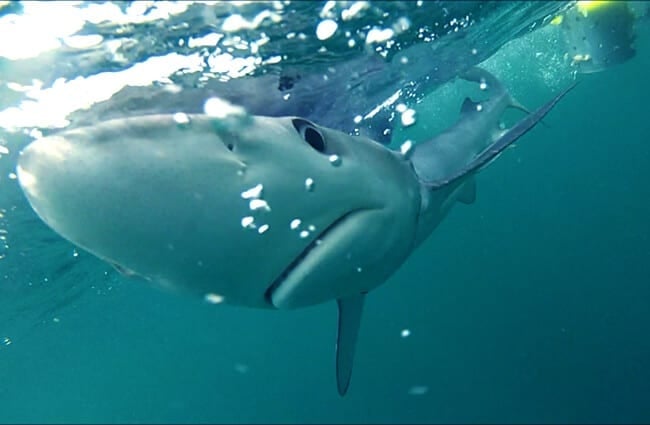Blue sharks are a lean, streamlined species related to spinner and reef sharks. Using that streamlined body, they participate in lengthy migrations. Sometimes those migrations even span across entire oceans! Their slender build allows them to swim quickly if they must. Read on to learn about the blue shark.
Description of the Blue Shark
The name doesn’t lie! Blue sharks are actually blue. They are darker blue on top, and lighter blue on their sides. Contrastingly, their underbellies are white rather than blue. These sharks can grow up to 10.8 ft. long. In fact, the largest recorded specimen was 12 ft. long, but this is out of the norm. Even though they are long, they can be very slender. The males are smaller than females, because larger sized females can produce more young.
Interesting Facts About the Blue Shark
Humans generally have a mixture of fear and fascination when it comes to sharks. However, with understanding comes respect, and sharks are no exception.
- Countershading – It may surprise you to learn that nearly all sharks have camouflage! It’s true, many shark species have a form of camouflage known as countershading. Because they are dark on top, and light on the bottom, they blend in with the ocean. When viewed from below, they look like the surface of the water. When viewed from above, they are dark, like the depths.
- Large Ladies – The females of this species greatly outweigh the males. Males normally weigh around 120 lbs. at the most, while some females can weigh up to 450 lbs. This should not come as a surprise, because females must be larger to carry more pups! Larger ladies produce more babies!
- Large Litters – A seriously big shark can produce a serious amount of pups. Depending on her size and health, a single female can birth anywhere from 5 – 130 pups. This is particularly surprising because each of those pups is over a foot long when it is born.
- Social Swimmer – When you picture a shark, you probably don’t think of a social creature. Blue sharks are one of the exceptions. They live in small groups called schools. Most shark schools are a single gender, either all male or all female.
Habitat of the Blue Shark
Blue sharks will live in both warm and cold waters, though they avoid the particularly frigid temperatures in the Arctic and Antarctic. Instead, they prefer temperate and tropical seas. When in warmer waters, these sharks swim in deeper water columns. In addition to temperature, they the oceanic area in which they live restricts them. Their preferred habitats are areas of open ocean.
Distribution of the Blue Shark
The blue shark is particularly widespread, as they live across the vast majority of the world’s oceans. However, they can only live in temperate and tropical temperatures. Because of this, they only thrive as far north as Norway, and as far south as Chile. When they are migrating, higher concentrations of populations can congregate in regional areas.
Diet of the Blue Shark
These sharks are particularly fond of squid, and will follow their movements to some extent. Also, the closely-related cuttlefish and octopus are common prey as well. Other meals include lobster, crabs, shrimp, fish, small sharks, and carrion. Surprisingly, these social sharks will work together while hunting to capture large schools of fish. This is unusual because most sharks hunt alone.
Blue Shark and Human Interaction
Like many other shark species, fishermen target blue sharks for shark-fin soup. The IUCN Red List estimates that fishermen harvest as many as 20 million individuals yearly.
In addition to shark-fin soup, fishermen use their meat for fishmeal, their liver for oil, and their skin for leather. On the other hand, blue sharks injure humans much less frequently. In the past 400+ years of recorded bite incidents, only 13 implicated blues.
Domestication
This shark species has not been domesticated in any way.
Does the Blue Shark Make a Good Pet
No, this species does not make a good pet. Because they can grow up to 10 ft. long, the average person cannot provide a large enough tank!
Blue Shark Care
It is difficult to care for these sharks. Adults are long and hard to transport safely into an aquarium setting. Researchers can transport smaller sharks with ease, but tend to become lunch for larger species in tanks.
Like many other shark species, its smooth surfaces prove difficult for these sharks. They can run into windows and sides of tanks, causing injuries to their heads. However, they do eat well in captivity.
Behavior of the Blue Shark
Unlike many other shark species, blue sharks are actually quite social. They live in small schools, and even work together while hunting for fish. The schools normally consist of all-male or all-females groups. These groups work together by swimming around large schools of fish. By swimming on either side, the sharks can push the fish into a smaller area and catch them.
Reproduction of the Blue Shark
Blue sharks give birth to live young, rather than laying eggs. This type of reproduction is viviparous birth. A yolk sac nourishes the pups until they are born. Surprisingly, females can give birth to very large numbers of pups. Some large females can even produce as many as 130 pups! Once the pups are born, they are fully self-sufficient and begin hunting on their own.







![Red Angus Closeup of a beautiful Red Angus cowPhoto by: U.S. Department of Agriculture [pubic domain]https://creativecommons.org/licenses/by/2.0/](https://animals.net/wp-content/uploads/2020/03/Red-Angus-4-238x178.jpg)












![Red Angus Closeup of a beautiful Red Angus cowPhoto by: U.S. Department of Agriculture [pubic domain]https://creativecommons.org/licenses/by/2.0/](https://animals.net/wp-content/uploads/2020/03/Red-Angus-4-100x75.jpg)

